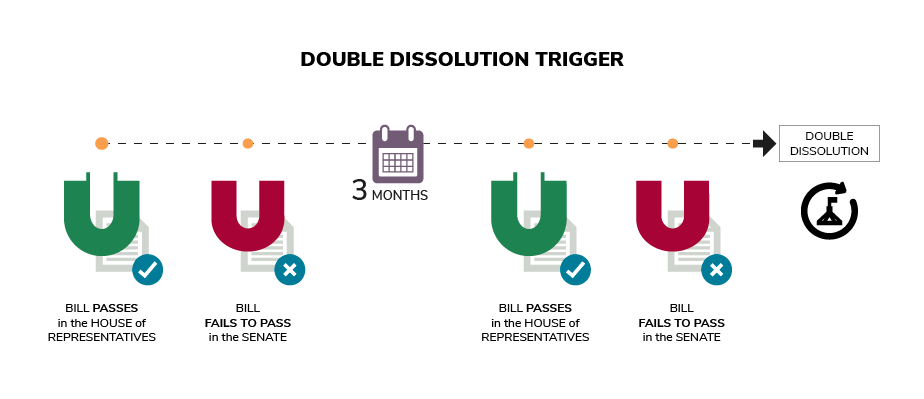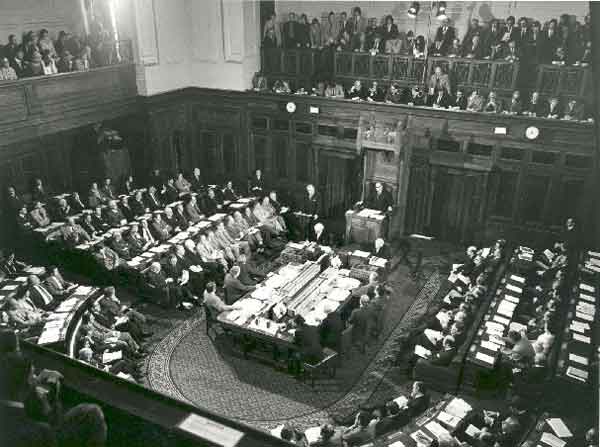Double dissolution
What happens when there is a deadlock between the Senate and the House of Representatives? This fact sheet explores double dissolutions and joint sittings of the Australian Parliament.
What will I learn?
- A double dissolution occurs when the Governor-General, on the advice of the Prime Minister, shuts down both the Senate and the House of Representatives for an election to take place.
- Section 57 of the Australian Constitution details the conditions for a double dissolution.
What is a double dissolution?
A double dissolution occurs when the Governor General, on the advice of the Prime Minister, dissolves – shuts down – both the Senate and House of Representatives for an election to take place. A double dissolution can only happen when there is a deadlock between the Senate and the House of Representatives on a bill – proposed law. A double dissolution is the only time all senators stand for election at the same time.
The Senate and House have almost identical powers and a bill must be agreed to by both to become law. If a bill is passed in the House of Representatives and does not pass twice in the Senate, Parliament can be dissolved for an election to be held to let voters decide on the outcome.
Procedure
Section 57 of the Australian Constitution details the conditions for a double dissolution to take place:
- The House of Representatives passes a bill and sends it to the Senate.
- The Senate rejects or fails to pass the bill, or passes it with amendments – changes – that the House will not agree to.
- Three months pass from when the Senate disagrees with the bill.
- The House passes the same bill and sends it to the Senate again.
- The Senate again rejects or fails to pass the bill, or passes the same bill with amendments to which the House will not agree.
Once these conditions have been met, the Prime Minister can recommend to the Governor-General that a double dissolution of the Parliament take place. A federal election will then be held to elect all members of parliament.
Double dissolution trigger

Parliamentary Education Office (peo.gov.au)
Description
The process for a double dissolution:
- bill passes in the House of Representatives
- bill fails to pass in the Senate
- three months pass
- bill passes in the House of Representatives
- bill fails to pass in the Senate
- double dissolution can be requested.
Copyright information
This work is licensed under a Creative Commons Attribution-NonCommercial-NoDerivs 3.0 Unported License.
You are free to share – to copy, distribute and transmit the work.
Attribution – you must attribute the work in the manner specified by the author or licensor (but not in any way that suggests that they endorse you or your use of the work).
Non-commercial – you may not use this work for commercial purposes.
No derivative works – you may not alter, transform, or build upon this work.
Waiver – any of the above conditions can be waived if you get permission from the copyright holder.
More than one bill can act as a trigger for a double dissolution.
A double dissolution cannot take place within 6 months of the end of a 3-year term of the House.
Joint sitting of Parliament
Joint sitting of the Australian Parliament, 1974

DPS Auspic
Description
This joint sitting of the Australian Parliament was held on 6 and 7 August 1974. It was the first, and so far the only, joint sitting in Australian history. Members of both the House of Representatives and the Senate gathered in the House of Representatives U-shaped seating to debate and vote on bills previously blocked by the Senate. Observers are sitting and standing in the raised balconies around the sides of the room.
Copyright information
Permission should be sought from DPS AUSPIC for third-party or commercial uses of this image. To contact DPS AUSPIC email: auspic@aph.gov.au or phone: 02 6277 3342.
Joint sitting of the Australian Parliament, 1974

DPS Auspic
Description
This joint sitting of the Australian Parliament was held on 6 and 7 August 1974. It was the first, and so far the only, joint sitting in Australian history. Members of both the House of Representatives and the Senate gathered in the House of Representatives U-shaped seating to debate and vote on bills previously blocked by the Senate. Observers are sitting and standing in the raised balconies around the sides of the room.
Copyright information
Permission should be sought from DPS AUSPIC for third-party or commercial uses of this image. To contact DPS AUSPIC email: auspic@aph.gov.au or phone: 02 6277 3342.
After a double dissolution election, the bill or bills that triggered the double dissolution may be introduced into Parliament again. If a deadlock happens between the Senate and House again, the Governor-General may call a joint sitting of all senators and members of the House of Representatives to vote on the bill or bills.
There has only been one joint sitting of the Australian Parliament. In 1974, the 6 bills that had triggered a double dissolution were reintroduced into Parliament and again rejected by the Senate. At the joint sitting, the government members all voted together and all 6 bills were passed.
History
There have been 7 double dissolutions of the Australian Parliament: 1914, 1951, 1974, 1975, 1983, 1987 and 2016. In 1914, 1975 and 1983, the government lost the election that resulted from the double dissolution. The most famous double dissolution occurred in 1975. Prime Minister Gough Whitlam did not want a double dissolution election; however, Governor-General Sir John Kerr dismissed the government and, on advice of caretaker Prime Minister Malcom Fraser, the Governor-General dissolved Parliament.
